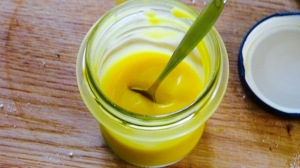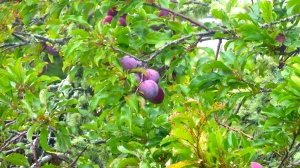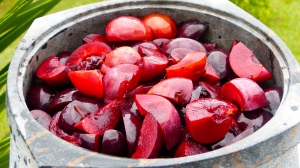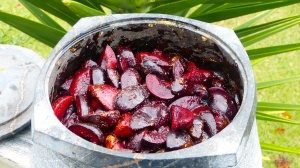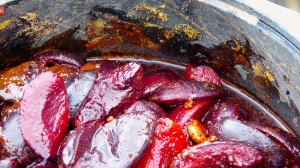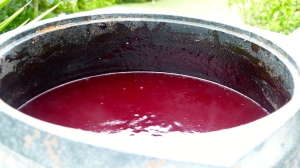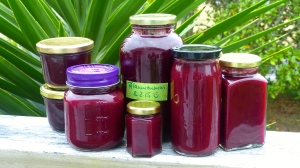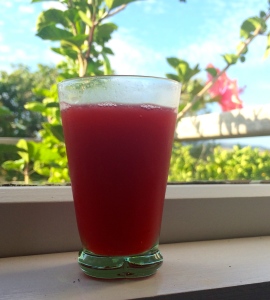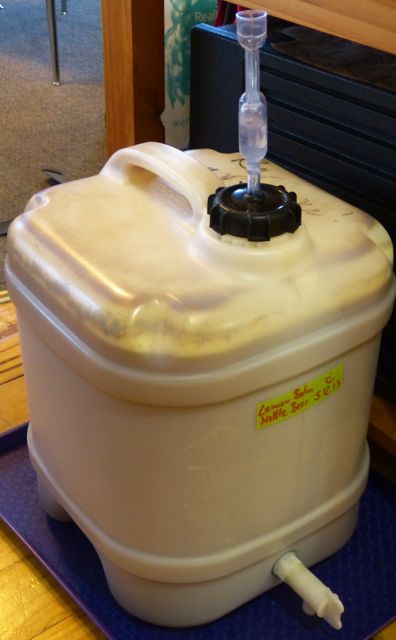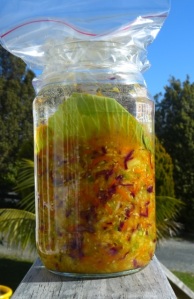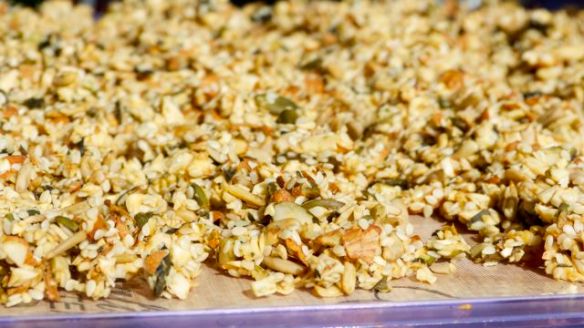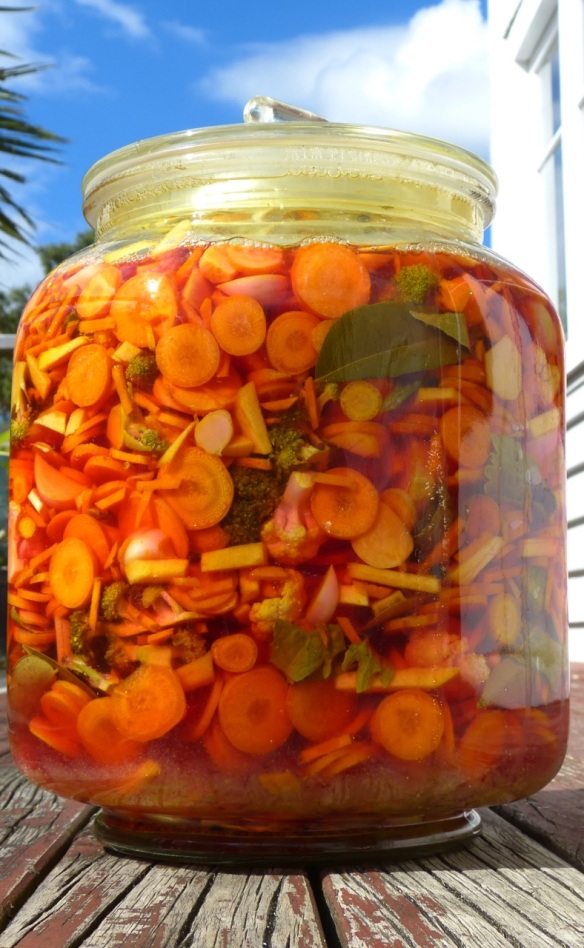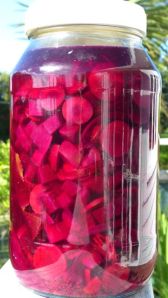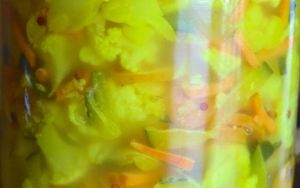OK ok, you’ve seen several recipes for spreads, jams and curds to put on bread. Here is the very carrier, a simple straight forward Spelt Sourdough bread.
I’ve found the recipe in Andrew Whitley’s book: Bread Matters. A very good book if you feel like getting serious about baking your own traditional breads. After baking rye sourdough breads as described by Sandor Ellix Katz with varying results over the past years, this spelt bread seems to work every single time. The other benefit is the short and simple fermentation process here. Normally the making of rye sourdough bread will take three fermentation steps over up to 24 hours. For a good working 100% rye sourdough bread recipe visit my dear friend and colleague’s, Rani Silva, website!
This easy spelt sourdough recipe here only requires a one step fermentation of 12 hours.
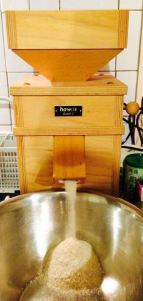 Once you’ve tried this recipe a few times and have bought the above mentioned book, you might consider the purchase of a grain mill. After years of slogging with a hand-operated Jupiter one, I’m now blessed with a Hawo’s Queen 2 electrical mill. Thanks Mum and Santa! 🙂
Once you’ve tried this recipe a few times and have bought the above mentioned book, you might consider the purchase of a grain mill. After years of slogging with a hand-operated Jupiter one, I’m now blessed with a Hawo’s Queen 2 electrical mill. Thanks Mum and Santa! 🙂
The difference it makes to have freshly ground flour for baking sourdough bread is tremendous! Apparently, most of the vital nutrients in grains oxidise and break down very shortly after the milling into flour.
Due to the sourdough fermentation the spelt and its gluten seem to be well digestible even by people like my dear wife, Lydia, who is normally very sensitive to gluten.
For this bread you will require a rye flour sourdough starter. Yes: rye. If you don’t have ‘weird’ friends who keep such a pet in their fridge or your house sitter threw your 300 year old sourdough starter out… (like Lydia managed to do once ;-)), make your own!
It should only take you 4-5 days in a warm spot (28-30°C) in your kitchen. A sourdough starter relies on the wild yeasts present on the grains/flour and in your kitchen environment. Each grain (wheat, spelt, rye, rice, barley…) and locality will develop a different sourdough culture, depending on the yeasts present.
Start with 25 g rye wholemeal flour and 50 g of warm (40°C) water. Stir it well. Keep it in a plastic tub with a simple lid that snaps into place or can easily flip open when pressure builds inside.
Each day add 25 g rye flour and 50 g or warm water, stir and return to its warm spot.
On day 4 your starter should start bubbling and taste lightly sour/fruity.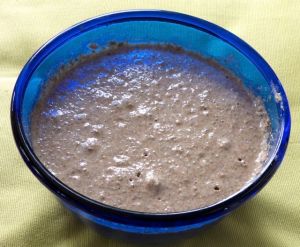
You can start using it in recipes now or keep it in the fridge until you need it. Then pull it out to warm to room temperature and add 1/2 cup or rye flour and 1/2 cup of warm water. Stir it well and wait til it starts bubbling again. This can take 8-12 hours. You are now ready to use your starter in a recipe like the one below by Andrew Whitley.
I suggest you double this recipe and bake two breads at a time. These loaves have a tendency to disappear rather fast. Should you have too much, just slice one loaf after a day or two and freeze it for later toasting and use.
Simple Spelt Sourdough Bread
★★★★★
Prep Time: 12 hours | Cook Time: 40 mins | Servings: 1 loaf | Difficulty: Easy
Ingredients:
80 g Rye Sourdough starter
350 g warm water
500 g stoneground wholmeal flour, Spelt
8 g sea salt
50 g seeds, optional (Sunflower-, Pumpkin-, Sesame-, Poppy seeds…)
Directions:
To make the bread, disperse your refreshed rye sourdough starter and salt with a whisk in the water and then mix in the flour and seeds. Knead to develop the gluten and adjust the moisture so that the dough is very soft.
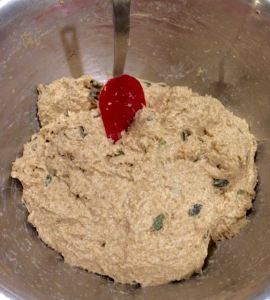
Any structure that you create by tight moulding will largely subside during a long proof, so do not expect a fine-domed top to a loaf such as this.

Dough in tins before rising
Place the dough in a greased and flour dusted loaf tin, cover it with a loose plastic bag and leave to rise. Do not put the tin in an especially warm place unless you want to hurry the process along. At an average kitchen temperature of about 20°C, this dough should rise in 10-12 hours. In winter I tend to put it onto the cupboard shelf above the crock pot with our continuous bone broth.

The risen dough in the tins
Bake in a hot oven at 230°C, reducing the temperature to 200°C after 10 minutes or so. Bake at 200°C for another 30 min for a total baking time of 40 min.

The finished bread
Since all the flour in this loaf has been fermented for a long period, the crumb will be markedly sticky immediately after baking, so it is better to leave it for a day before cutting it. Its keeping quality, however, is remarkable. Even better, the science suggests that a long rise with lactic acid bacteria from the rye sourdough starter and its unique micro-biom will neutralise almost all the phytic acid present in the wholemeal flour bran, making important minerals such as iron, magnesium, calcium and zinc more available to your body than they would be in an ordinary yeasted wholemeal bread.
———————-
So there you have it! Feel free to post your success stories or accidents below!
Best of Success and Bon Apetit!












